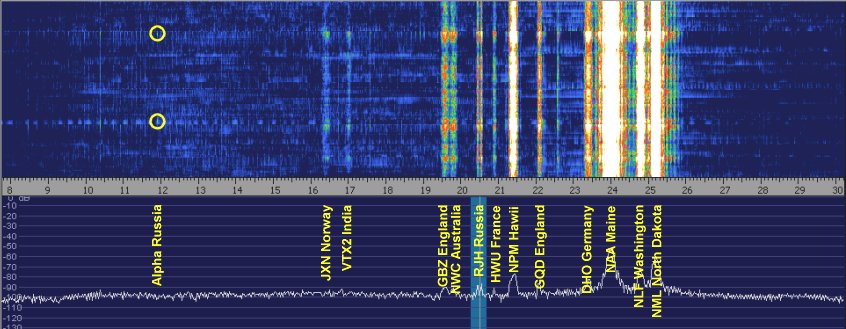|
|
| 11.9 kHz - Alpha - Russia - mp3 of Alpha 'beeps'recorded 02/12/11 |
|
| 12.7 kHz - Alpha - Russia |
|
| 14.9 kHz - Alpha - Russia |
|
| 16.4 kHz - JXN - Norway |
| 17.0 kHz - VTX2 - India |
| 17.2 kHz - SAQ - Sweden - mp3 of SAQ recorded 07/03/11 |
|
| 17.8 kHz - Tacamo - Airborne |
|
| 18.1 kHz - RDL - Russia |
|
| 18.3 kHz - HWU - France |
|
| 19.2 kHz - VTX4 - India |
|
| 19.6 kHz - GBZ - England |
|
| 19.8 kHz - NWC - Australia |
|
| 20.2 kHz - RJH69 - Belarus |
|
| 20.3 kHz - ICV - Italy |
|
| 20.5 kHz - RJH - Russia |
|
| 20.9 kHz - HWU - France |
|
| 21.1 kHz - RDL - Russia |
|
| 21.4 kHz - NPM - Hawaii |
|
| 21.75 kHz - HWU - France |
|
| 22.1 kHz - GQD - England |
|
| 22.2 kHz - JJI - Japan |
|
| 22.6 kHz - Tacamo - Airborne |
|
| 23.0 kHz - RJH - Russia |
|
| 23.4 kHz - DHO - Germany |
|
| 24.0 kHz - NAA - Maine |
|
| 24.8 kHz - NLF - Washington |
|
| 25.2 kHz - NML - North Dakota |
|
| 25.5 kHz - RJH - Russia |
|
| 26.0 kHz - DG2 - Israel |
|
| 26.7 kHz - TBB - Turkey |
|
| 37.5 kHz - TFK - Iceland |
|
| 40.0 kHz - JJY - Japan - mp3 of JJY ID recorded 02/02/11 |
|
| 40.75 kHz - NAU - Puerto Rico |
| 44.2 kHz - SWE - Sweden |
|
|
| 45.9 kHz - NSY - Italy |
|
| 51.95 kHz - GYW - Scotland |
|
| 53.4 kHz - TBG - Turkey |
|
| 55.5 kHz - NPG - California |
|
| 57.4 kHz - NRK - Iceland |
|
| 60.0 kHz - WWVB - Colorado |
|
| 60.0 kHz - MSF - England |
|
| 62.6 kHz - FUG - France |
|
| 65.8 kHz - FUE - France |
|
| 66.7 kHz - RBU - Russia |
|
| 68.5 kHz - BPC - China |
|
| 73.6 kHz - CFH - Nova Scotia |
|
| 75.0 kHz - HBG - Switzerland |
|
| 76.2 kHz - CKN - Vancouver |
|
| 77.5 kHz - DCF77 - Germany |
|
81.0 kHz - MKL - Scotland
|
|
The receiving setup here has evolved over the years and a number of receivers, antennas and noise mitigation techniques have been evaluated. The best setups so far are 1) modified Amrad e probe antenna / indoor low noise preamplifier / Delta 44 sound card / Spectrum Lab or Winrad software and 2) modified Amrad e probe antenna / Perseus SDR receiver.
When considering the signal to noise equation at VLF and LF, the problem is seldom gathering enough signal. Most properly designed antennas, even though physically small, supply more than adequate levels such that the background 'band noise' significatly overides the preamplifier/receiver noise. The real improvement in signal to noise comes from reducing man made noise to get down to the 'natural' noise floor. This usually requires a combination of noise mitigation techniques. Once the receiving setup is able to hear a clean 'natural' noise floor directional antennas, such as the large format K9AY, can be used to additional advantage.
|
